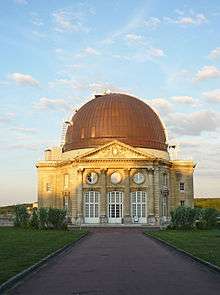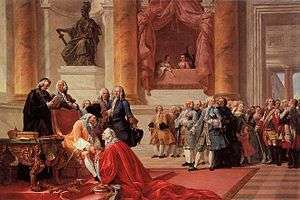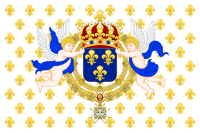Château de Meudon

The former Château de Meudon, on a hill in Meudon, about 4 kilometres southwest of Paris, occupied the terraced steeply sloping site. It was acquired by Louis XIV, who greatly expanded it as a residence for Louis, le Grand Dauphin. It was largely ignored under Louis XV and Louis XVI, but became the official residence of the King of Rome from 1812, and was occupied by Jérôme Bonaparte under the Second Empire. The main building was largely destroyed in a fire in 1871, and it is now the site of the Observatoire de Paris-Meudon.
History
Nothing is known of the medieval fortress that preceded the manoir du Val de Meudon before the 14th century. In 1527, the castle was given by Cardinal Antoine Sanguin to his niece Anne de Pisseleu, duchesse d'Étampes, mistress of François I. Around 1540, a Renaissance style château, was completed at the edge of the present terrace.
In 1552, the duchesse d'Étampes ceded the château to Charles, Cardinal of Lorraine, who embellished its interiors and created Renaissance style gardens commemorated in poetry by Pierre de Ronsard. The Italian architect, painter and sculptor Primaticcio executed the grotto in the Italian mode, with rooms carved in the rock and filled with fountains. Remnants of the terrace that supported it now support the great dome of the Paris Observatory. The orangery that survives may have substantial 16th-century origins as well.
At the death of Cardinal Sanguin in 1574, Meudon reverted to the House of Guise until 1654, when, battered by the Wars of Religion and the Fronde, it was purchased by Abel Servien, surintendant des finances, who launched ambitious works of rebuilding during the five years in which he possessed it. Meudon was renovated and enlarged, probably by Louis Le Vau, who constructed a double-height oval salon. The present terrace—260 metres long, 140 m wide and 14 m high at its retaining wall— was established, a vast project of manual earth-moving.
In 1679, the château was sold by Servien's heir to Louvois, the minister of Louis XIV, who continued to improve it inside and out, until his death in 1691. Above all, he commissioned André Le Nôtre to construct grand gardens and fountains fed by elaborate hydraulic works.
Le Grand Dauphin, son of Louis XIV

In June 1695,[1] Louis XIV purchased Meudon from the widow of Louvois, with the intention of installing his only surviving legitimate child le Grand Dauphin in the premises. A brilliant period followed. The Dauphin employed Jules Hardouin-Mansart and the office of the Bâtiments du Roi, but most particularly his long-term "house designer" Jean Bérain head of the Menus-Plaisirs du Roi, to provide new decors, in which the first glimmers of the Régence style, precursor to the Rococo, can be detected.[2] An early innovation at Meudon was the cabinet à la capucine in the entresol, where the carved oak boiseries were left in their natural color and simply varnished. The main campaign was begun in 1699, with ceiling paintings by Audran, resulting in the grand cabinet de Monseigneur, viewed by the king in August 1699 and commemorated in the portrait Le Grand Dauphin dans son cabinet now at Versailles (illustration, left), which offers a rare glimpse of this interior,[3] furnished with a desk by André-Charles Boulle, who also provided the gilt-bronze architectural elements of the fireplace, in the new fashion with a tall mirror above it. Berain engraved some of the arabesque panels for the grand cabinet, which gave the new designs a wide circulation.
In 1702, the chapel was completed and consecrated, and the aile des marronniers. Taking the place of Primaticcio's grotto, the château neuf de Meudon was constructed, employing some of the old foundations; it was substantially complete by 1706. This is the structure that survives today, supporting the great observatory dome. With the death of the Dauphin in 1711, and that of his eldest son, Louis, duc de Bourgogne, the following year, the spirit went out of Meudon.
In November 1718, Marie Louise Élisabeth d'Orléans, Duchess of Berry, daughter of the Regent, Philippe II, Duke of Orléans, exchanged the Château d'Amboise, which she owned, against that of Meudon, and entrusted the estate to her paramour, the count of Riom. The duchesse de Berry had no time to enjoy the pleasures of her new residence. Being in the family way, presumably by Riom, the young duchess tried to hide her state, partying and drinking heavily as usual. After a very laborious childbirth which almost killed her at the Luxembourg Palace, she retired to Meudon on 12 April 1719, hoping to regain her health and lessen the scandal caused by her delivery. On 1 May the Duchess gave her father a supper-party on the terrace at Meudon. The Regent had just sent Riom to his regiment on the Spanish border. She wanted him to cancel his order and thought that the party would silence public suspicion that she had borne a child. But the Regent would not bend and his daughter merely caught a chill.[4] Her condition going from bad to worse, the Duchess left Meudon on 14 May and died on 21 July at the Château de la Muette.[5]
Under Louis XV & Louis XVI
Louis XV employed Meudon as a hunting lodge. Although his mistress, Madame de Pompadour, was installed in the nearby Château de Bellevue, Meudon was eclipsed in his favour by the Château de Choisy. Meudon declined further under Louis XVI, the parterres overgrown, the basins emptied, the park let piecemeal to tenant farmers.
Under The Revolution and French Empires
Meudon was emptied out in the Revolutionary sales, and royal insignia were chiselled off its façades. The Château Neuf was employed as a manufactory producing balloons, one of which served as an aerial lookout at the battle of Fleurus. A disastrous fire in 1795, followed by looting, resulted in the demolition of the Château Neuf in 1803. Its pink marble columns went to decorate the Arc de Triomphe du Carrousel in front of the Tuileries, and the stone columns to the little garden rotunda of the Palais du Luxembourg.

In 1807, Napoleon decided to rebuild the Château Neuf, which became the official residence of the King of Rome in 1812. Meudon remained dark during the Bourbon Restoration, but was used from time to time under the July Monarchy. Jérôme Bonaparte resided in it under the Second Empire and his son, Prince Napoleon.
In 1870, the terraces of Meudon were part of the strategic defenses of Paris in the Franco-Prussian War, and the château, damaged by shelling,[6] was occupied by Prussian forces. Forty-eight hours after the signing of the armistice, in January 1871, Meudon caught fire. It burned for three days, until only some exterior walls were left standing
Current Status
Jules Janssen chose this site as the location for the present observatory in 1874, in preference to Malmaison, and it was built partly incorporating some of Meudon's exterior stonework. Some of the outbuildings are inhabited today by astronomers attached to the Observatoire. Its history since that date can be followed at Observatoire de Paris.
Notes
- ↑ Kimball 1943, p 50
- ↑ Kimball 1943, p 51.
- ↑ Kimball 1943, pp.59, 64-66, fig 46.
- ↑ H. Noel Williams, Unruly Daughters : A Romance of the House of Orleans, p.180
- ↑ http://chateau-meudon.wifeo.com/chronologie.php
- ↑ Albumen photographic prints at Northwestern University show the damage before the fire: .
References
- Fiske Kimball, The Creation of the Rococo, (Philadelphia Museum of Art) 1943.
External links
- The Web page about the "Château de Meudon" (French)
- Châteaux de Meudon (French)
- Engravings of the Château de Meudon.
- Construction of the Observatoire de Paris at Meudon. (French)
Coordinates: 48°48′18″N 2°13′52″E / 48.80500°N 2.23111°E
